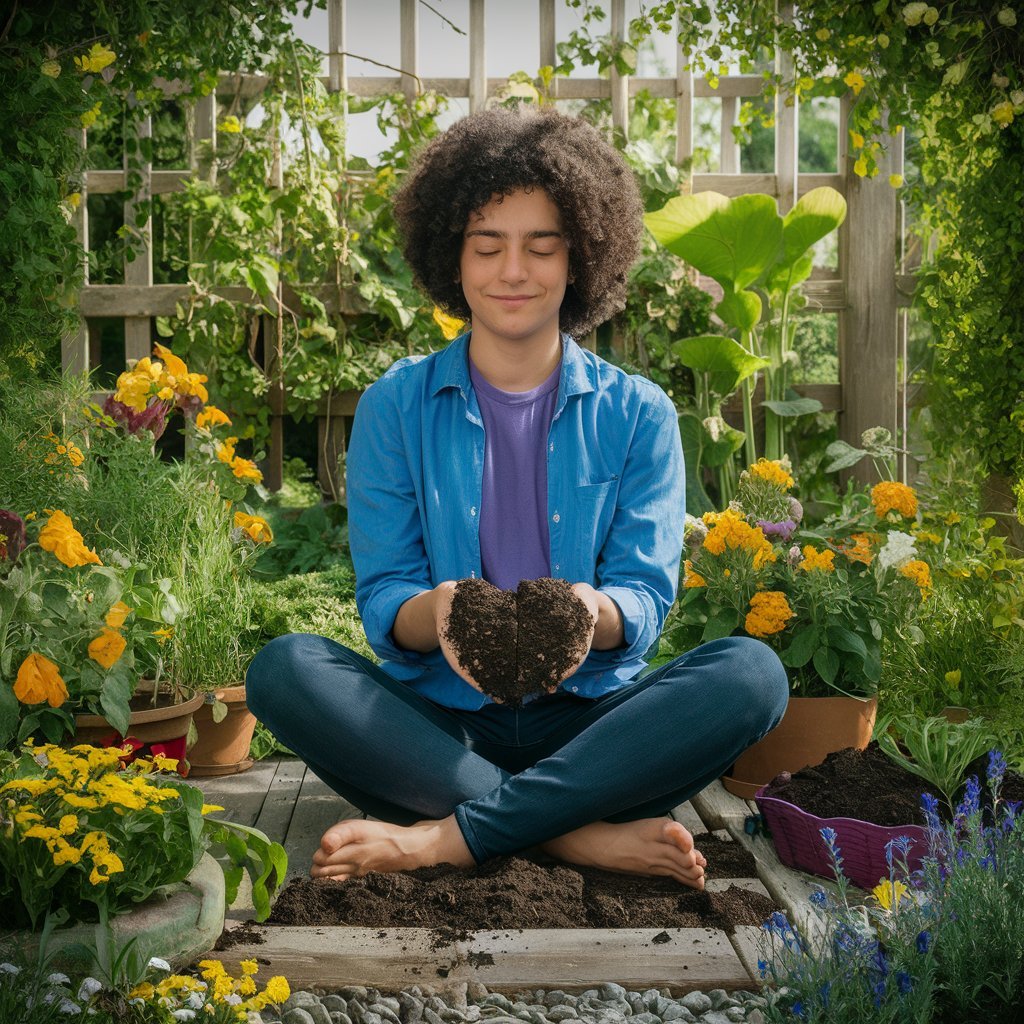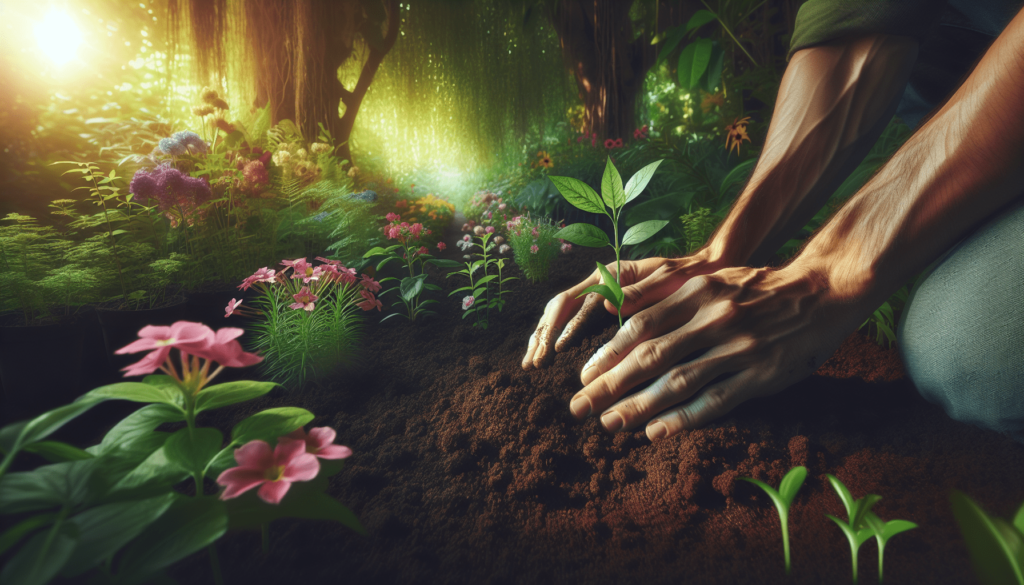Have you ever wondered how something as simple as planting a seed could help heal the human spirit? It’s an idea both ancient and novel, that the soil beneath your feet holds the potential to nurture not just plants, but also your journey through addiction recovery. This is where gardening enters the picture.

The Interwoven Journey Between Nature and Healing
The concept that nature offers healing isn’t new. For centuries, people have turned to the earth, drawn to its grounding presence, its cycles mirroring our own. Addiction recovery, a path often fraught with labyrinthine twists and turns, can find surprising moments of stability and hope in the humble act of tending a garden.
In fastening your life to the rhythms of the natural world, you may discover more than just an escape; you might find a profound connection.
Nature’s Influence on Mental Well-being
When you’re ensnared in the grip of addiction, the mind can feel like an uninhabitable place, full of shadows and despair. Entering a garden changes all of that. Studies consistently show that spending time in nature alleviates symptoms of depression, anxiety, and stress. A walk amidst blooming flowers, the act of pruning, or just sitting under a tree can act as a salve for a wounded spirit.
The Science Behind Nature’s Healing Power
The magic of nature on mental health isn’t just folklore. Research in ecopsychology has shown that natural settings reduce levels of cortisol, the stress hormone, in the brain. Lower cortisol levels mean reduced anxiety, better mood, and improved focus—key elements when you are working through recovery.
| Benefit | Mechanism |
|---|---|
| Reduced stress | Lower cortisol levels |
| Improved mood | Increase in serotonin and dopamine |
| Enhanced focus | Attention Restoration Theory |
| Better overall health | Reduced blood pressure, better sleep patterns |
Finding Purpose in the Soil
One of the cruellest tricks of addiction is how it saps a sense of purpose. You may find yourself adrift, recognizing neither your past self nor a hopeful future. Here, the garden acts as a microcosm of life’s cycles, offering tangible tasks and visible rewards.
The Therapeutic Act of Planting
Think about the humble seed. You take it, expectant, and bury it in the soil. Days turn into weeks, and with care, it pushes through the soil, growing, thriving. This can be a potent metaphor for your own journey. Planting isn’t just about the end goal but also about nurturing something through its stages.
Being responsible for a life, even a plant’s life, re-instills a sense of accountability and purpose. The garden becomes a mirror, reflecting the transformation happening within you.
The Garden as a Safe Space
Addiction isolates people, pulling them away from loved ones and leading them into a world of secrecy and shame. A garden, however, is an open space, welcoming you just as you are.
Community and Connection
Gardens aren’t always solitary endeavors. Community gardens, in particular, provide a connective thread back to society. You’re shoulder to shoulder with others, sharing tools, advice, and experiences. This sense of community and shared responsibility can be incredibly therapeutic.
| Aspect | Impact on Recovery |
|---|---|
| Sense of belonging | Reconnects you with social circles |
| Shared experiences | Offers mutual support and understanding |
| Collaborative goals | Teaches teamwork and collective success |
| Safe space for expression | Reduces feelings of isolation and promotes open communication |
Social Support and Accountability
Gardening with others isn’t just about the plants; it’s about human connection. Sharing your journey, your setbacks, and your triumphs with those who understand can be profoundly liberating. This community can act as a support system, helping to keep you accountable and engaged in your recovery process.
The Garden as a Personal Sanctuary
Beyond any community interaction, a garden is a sanctuary where you can be alone with your thoughts, yet not feel lonely. The demands of caring for living things bring enough structured distraction to quiet racing thoughts, offering mental clarity.
Physical Benefits of Gardening
Gardening isn’t just a mental exercise; it’s a physical one too. The very act of raking, digging, planting, and weeding provides a form of exercise that is both gentle and rewarding.
The Physicality of Healing
Engaging in physical activity releases endorphins, those natural mood lifters. The repetitive motions of gardening can be especially beneficial for reducing anxiety and improving overall physical health. You’ll find yourself bending, lifting, and moving in ways that improve flexibility and strength, enhancing your bodily well-being.
| Activity | Physical Benefits |
|---|---|
| Digging and lifting | Strengthens muscles, improves cardiovascular health |
| Weeding and pruning | Enhances flexibility, promotes fine motor skills |
| Planting and sowing | Encourages full-body movement |
| Walking and exploring | Offers low-impact cardiovascular exercise |
Reconnecting with Your Body
Addiction can often lead to a disconnect between mind and body. By engaging in gardening, you literally get your hands dirty, reminding yourself of the sensory experiences that go hand-in-hand with physical sensation. This reconnects you to your body, which is a crucial aspect of holistic recovery.
Cultivating Patience and Mindfulness
Gardening is the epitome of delayed gratification. Seeds don’t germinate overnight, and plants don’t grow at your beck and call. This teaches patience and the value of slow, steady progress, concepts that are often hard to grasp when you’re in recovery.
Mindful Gardening
One of the most significant mental benefits attributed to gardening is the development of mindfulness—the practice of focusing entirely on the present moment. This can be a powerful tool against the urges and cravings that come with addiction.
Seasonal Changes and Adaptability
Gardens go through phases: spring rebirth, summer flourishing, autumn decay, and winter rest. These cycles can mirror your recovery journey, teaching you to accept and adapt to change gracefully.
By working with these natural phases, you learn resilience and flexibility. If a plant doesn’t thrive, you adjust—perhaps offering it more water, more light, or a different soil. This adaptability, this ability to change course, is invaluable when facing the unpredictable nature of recovery.

Practical Steps to Start Gardening
The concept sounds wonderful, but how do you get started? Whether you have acres of land or just a windowsill, gardening can adapt to your circumstances.
Starting Small
Begin with something manageable. A few pots on a windowsill or a small patch in your backyard can be initially less daunting than a vast, uncharted garden space. Choose plants that are easy to grow and maintain, giving yourself the best chance of immediate success.
| Plant Choice | Ideal For | Maintenance Level |
|---|---|---|
| Herbs (Basil, Mint) | Indoor windowsills, small pots | Low |
| Tomatoes | Small plots, pots | Medium |
| Succulents | Anywhere with sufficient light | Very Low |
| Lettuce | Gardens, containers | Low |
Seeking Guidance
Gardening books, online forums, local garden centers, or community gardening groups can provide a wealth of information and support. Don’t hesitate to ask seasoned gardeners for advice; they are generally eager to share their love for the craft.
Local Resources and Workshops
Your local community may offer workshops or classes in gardening. These can serve dual purposes: equipping you with gardening skills and integrating you into a supportive social network.
Integrating Gardening into Your Recovery Plan
A well-rounded recovery plan often includes multiple avenues of support: counseling, medication, exercise, and social interaction. Integrating gardening into this framework can offer a holistic balance.
Creating Structure in Your Day
Addiction often disrupts the natural rhythms of daily life. Establishing a gardening routine can help reintroduce structure. Whether it’s watering plants in the morning or weeding every afternoon, these small rituals provide a framework that helps you organize your day.
Combining with Therapy
Many recovery programs now recognize the value of horticultural therapy, an approach that combines gardening activities with therapeutic practices. Gardening can be a hands-on extension of the work done in counseling sessions, offering a way to process emotions and experiences physically.
Tracking Progress and Reflecting
Maintaining a garden journal can be a beneficial practice. By tracking your garden’s progress, you simultaneously track your own. Noting what works, what doesn’t, and reflecting on your feelings throughout can provide insights into both your gardening and recovery journey.
The Symbolic Power of Growth
Planting seeds and watching them grow offers more than just tangible rewards. The garden can become a powerful symbol of your own growth and transformation.
Nurturing Growth and Blooming
As your plants thrive, so do you. Each new leaf, every blooming flower symbolizes your steps forward. The tangible results of your hard work mirror the often unseen but deeply felt transformations occurring within you.
Encountering Setbacks
Gardens aren’t without their problems: pests invade, plants succumb to disease, weather wreaks havoc. These setbacks can serve as metaphors for the struggles you face in recovery. Encountering and overcoming these challenges in the garden helps build the resilience needed to face real-world obstacles.
A Continuous Journey
Gardening is not a one-time fix; it’s a continuous journey. Just as plants need ongoing care, so does your path to recovery. Gardens grow, change, and sometimes fail, but the act of nurturing them teaches you that the process itself is incredibly valuable.
Celebrating Small Wins
In the context of addiction recovery, it’s vital to celebrate small victories. A thriving plant grown from a seed, a first flower, or a plentiful harvest are all milestones worth celebrating. These successes reinforce the positive behaviors and choices that contribute to your overall recovery.
When you stick your hands into the soil, when you nurture that green shoot into a full-grown plant, you’re not just tending to a garden—you’re nurturing a part of yourself. The earth, in its quiet wisdom, offers sanctuary and healing. It teaches patience, awareness, and resilience. Through gardening, you can find not just a pastime, but a pathway to reclaiming your life, step by painstaking, wonderful step.
Gardening might merely seem like planting and watering, but it’s more than that; it’s an act of healing, an embrace from nature itself. Your journey through addiction recovery can find a steadfast ally in the soil beneath your fingertips. Healing Earth, indeed.

My name is Michelle Warren, and I’m the founder of Peaceful Gardening. As a 10-year breast cancer survivor, I’ve discovered the profound therapeutic power of gardening. This journey has not only helped me recover but has also become my passion and a source of ongoing peace and joy.
Peaceful Gardening was born from my desire to share the healing benefits of gardening with others. Whether you’re facing health challenges, dealing with stress, or simply looking to connect more deeply with nature, this space is for you.
Over the past decade, I’ve cultivated not just plants, but a deep understanding of how gardening can positively impact mental health. I’ve worked with local community gardens, led workshops on mindful gardening practices, and collaborated with mental health professionals to develop gardening-based stress reduction programs.
Peaceful Gardening was born from my desire to share the healing benefits of gardening with others. Whether you’re facing health challenges, dealing with stress, or simply looking to connect more deeply with nature, this space is for you.
Here, you’ll find evidence-based advice on using gardening as a tool for mindfulness, stress relief, and emotional healing. I share personal stories, practical tips, and scientifically-backed information on how to create your own therapeutic garden space, no matter the size of your yard or balcony.
My mission is to help you discover the joy, peace, and healing that comes from nurturing plants and connecting with nature. Join me in exploring how the simple act of tending to a garden can transform your mental and emotional wellbeing.
Welcome to Peaceful Gardening – let’s grow together towards better mental health!”
